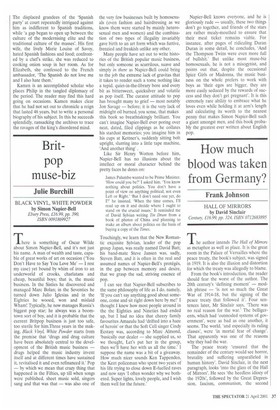A king in fits and starts
Raymond Carr
PHILIP V OF SPAIN by Henry Kamen
Yale, £25, pp. 283, ISBN 0300087187
Kings and queens, in those European states where they survive as heads of state, are now politically powerless ceremonial symbols. But in the ancien regime kings did not merely reign, they ruled. Their virtues or shortcomings counted. Henry Kamen has, in his splendidly researched biography, rescued Philip II from the rough handling he has received, particularly at the hands of liberal historians. In this book, he does likewise for Philip V.
Philip, Duke of Anjou and grandson of Louis XIV, came to the throne of Spain in 1700 because the last Habsburg king, the sickly Charles II, died without producing an heir, that one essential task of a monarch. In his will he bequeathed his throne to Philip. Louis XIV saw in this an opportunity to convert Spain into a satellite kingdom of France. A boy of 17, so lacking in self-confidence that he listened to the debates of his ministers behind a curtain, Philip did not relish the job his grandfather had imposed on him. 'I would rather go back to being Duke of Anjou. I can't stand Spain.' It is Kamen's contention that never theless he became a conscientious and hard-working king of his adopted country. But for long periods he was out of action, victim of a 'serious neurological disorder'. He would lie in bed for days howling and mouthing nonsense, refusing to have his clothes or bed sheets changed, his nails or hair cut, claiming that he was dead or a frog, and that his head was empty and about to fall off his shoulders.
Even when he was apparently restored to his senses, his behaviour was bizarre. He turned night into day, receiving ambassadors and ministers half naked in his scanty nightshirt. 'It is not yet five o'clock in the morning,' his second wife Elizabeth Farnese wrote to her son, 'and we have not had supper'. Without her devoted care he would not have functioned at all. She detested but accepted his absurd timetable, savage outbursts of temper, sitting by his bedside as he lay in his stinking clothes. It was she who invited the great castrato singer Farinelli to Spain, to sing every night to ward off the king's fits of depression.
Contemporaries complained that he was dominated by Elizabeth, for example in her determination to find an Italian throne for her favourite son. She always claimed that decisions were the king's alone; but in a masculine political world she would, wouldn't she? Philip himself wandered through the Alcazar in Seville, muttering suis le maitre.' But he was not. For long periods of time, it was his queen who took over. Obsessed by death and the salvation of his soul, perhaps even aware of his shortcomings, he abdicated in 1744, only to resume the throne when his son, King Louis, died. Elizabeth locked him in his room to stop him repeating the performance. Conscientious king he may have been, but he built the palace of La Granja to get away from Madrid and the burdens of kingship, playing billiards with Elizabeth on wet afternoons. It is a sign of the disintegration of his personality that he had given up hunting, once his favourite sport.
Kamen stresses Philip's virtues. He was the last warrior king of Spain. In the long struggle to secure his throne against his Austrian rival who was supported by Britain and the Dutch, who feared a French-dominated Europe, the king took an active part in the war. War proved 'a supreme therapy', ridding him of the black dog of depression. Kamen rightly emphasises that Philip's reign saw a remarkable recovery of Spain as a great power after the losses inflicted by the victorious allies. French-style administrative reforms replaced the ramshackle councils, dominated by Spanish grandees, with an assortment of French and foreign ministers and, later, by low-born Spanish civil servants.
In what sense was he a Spanish king? He clearly would have preferred to succeed Louis XIV as king of France. He thought and spoke in French and his observers noted that he danced in the French style.
The displaced grandees of the 'Spanish party' at court repeatedly intrigued against him as indifferent to Spanish traditions, while 'a gap began to open up between the culture of the modernising elite and the traditional culture of the masses'. His first wife, the lively Marie Louise of Savoy, hated Spanish fashions and food; confronted by a chefs strike, she was reduced to cooking onion soup in her room. As for Elizabeth, she confessed to the French ambassador, 'The Spanish do not love me and I also hate them.'
Kamen is an accomplished scholar who places Philip in the tangled diplomacy of the period. The reader may find this hard going on occasions. Kamen makes clear that he had not set out to chronicle a reign that lasted 46 years, but to write a personal biography of his subject. In this he succeeds splendidly, ransacking the archives to trace the ravages of the king's disordered mind.



































































 Previous page
Previous page